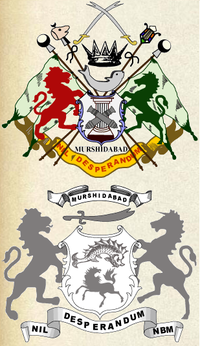| Nawab Nazim of Bengal (1717–1880)a Nawab Bahadur of Murshidabad (1882–1971)b | |
|---|---|
 Coat of arms of the Nawab Nazim (top) and that of the Nawab Bahadur (bottom) | |
| Creation | 1717 |
| First holder | Murshid Quli Khan |
| Last holder | Waris Ali Mirza |
| Present holder | Abbas Ali Mirza |
| Status | De facto only, not de jure |
| Extinction date | 1971 |
| Seat(s) | Murshidabadc |
| Former seat(s) | Hazarduari Palace, Murshidabad |
| Motto | Nil Desperandum (There is no cause for despair, never despair) |
| a. Title abolished in 1880, succeeded as the Nawab Bahadur of Murshidabad. b. Derecognition of rulers and abolition of Privy Purse by the twenty-sixth amendment of the Indian Constitution, in 1971.[1] c. Murshidabad was the capital for both the Nawab Nazims and the Nawab Bahadurs. | |
The Nawabs of Bengal (the Nawab Nazim of Bengal, Bihar, and Orissa) were Shia Muslim rulers of Bengal, and significant portions of present-day Bihar and Orissa. With their capital in Murshidabad, they ruled the Mughal Bengal subah, while nominally subordinate to the Mughal empire, in between 1717 and 1772. Nawab Siraj ud-Daulah, the last independent Nawab of Bengal, lost the Battle of Plassey to the British East India Company in 1757. He was betrayed by Mir Jafar in the battle, who was subsequently installed as the titular Nawab Nazim. Following the victory in Plassey, the British East India Company established itself as a strong political power-hold in the region of Bengal. In 1765, the system of dual government came to be established, as per which the Nawabs ruled subordinate to the British. In 1772, the system was abolished and Bengal was brought under direct control of the Company. When the nizamat (administration, judicial, and military powers) of the Nawab was also taken away in 1793, they remained as the mere pensioners of the Company.[2][3] Following the abolition of the title of Nawab of Bengal in 1880, the last Nawab of Bengal, Mansur Ali Khan, abdicated on 1 November 1880, in favour of his eldest son, Hassan Ali Mirza.[4]
The Nawabs of Murshidabad (Nawab Bahadur of Murshidabad) succeeded the Nawabs of Bengal, following Mansur Ali Khan's abdication[5] They had no direct control in the share of the revenue collected and could not use military force. The fourth Nawab Bahadur, Waris Ali Mirza died in 1969, and a long dispute over succession ensued.[6] Meanwhile, the policy of Privy Purse, which had allowed nobles to keep some of their privileges and titles, stood abolished in 1971 by the twenty-sixth amendment of the Constitution of India, derecognising all such rulers. Eventually, in August 2014, the Supreme Court of India decided on the dispute over succession to Waris Ali, in which one Abbas Ali Mirza was declared to be his lawful heir; Waris Ali Mirza was his maternal uncle. The hereditary title today is de facto only as it is not recognised by Indian law.
- ^ "Twenty Sixth Amendment to the Indian Constitution". Indiacode.nic.in. 28 December 1971. Archived from the original on 6 December 2011. Retrieved 1 May 2017.
- ^ Singh, Vipul (2009). Longman History & Civics (Dual Government in Bengal). Pearson Education India. pp. 29–. ISBN 9788131728888. Archived from the original on 4 October 2017. Retrieved 13 February 2016.
- ^ Madhya Pradesh National Means-Cum-Merit Scholarship Exam (Warren Hasting's system of Dual Government). Upkar Prakashan. 2009. pp. 11–. ISBN 978-81-7482-744-9.
- ^ "Murshidabad History - Feradun Jah". Murshidabad.net. 8 May 2012. Archived from the original on 2 September 2012. Retrieved 10 August 2012.
- ^ "Hassan Ali Mirza's succession". Murshidabad.net. 8 May 2012. Archived from the original on 2 August 2012. Retrieved 10 August 2012.
- ^ "Murshidabad History - Waresh Ali". murshidabad.net. Archived from the original on 24 August 2012. Retrieved 10 August 2012.